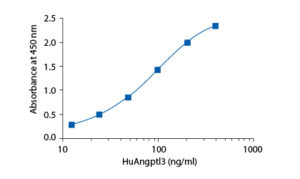Angiopoietin-Like Protein 3 Human ELISA
Angiopoietin-like Protein 3 (Angptl3) is one from six members of Angiopoietin-like (Angptl) family of proteins, which has been identified as orphan ligands with structural similarity to angiopoietins. Angptl3 has 490-amino acid residues and its expression is restricted to the liver.
Angptl3 and Angptl4 have been shown to regulate fat, lipid or glucose metabolic homeostasis. Angptl3 is a hepatocyte-derived circulating factor that affect lipid metabolism and is involved in regulating lipid storage and breakdown.
Overexpression of Angptl3 or intravenous injection of the purified protein in mice elicited an increase in circulating plasma lipid levels. Angptl3 decreases very low density lipoprotein (VLDL) triglyceride clearance by inhibiting lipoprotein lipase (LPL) activity, directly targeting adipose cells to activate lipolysis. This results in an increased release of free fatty acid (FFA) and glycerol from adipocytes. These observations indicate that Angptl3 might regulate lipid metabolism by inhibiting LPL and by stimulating lipolysis in adipocytes.
Recent findings suggest that elevated levels of Angptl3 in diabetic states might be involved in inducing hypertriglyceridemia and hyperfattyacidemia in diabetes and obesity. Hypertriglyceridemia causes triglyceride accumulation in peripheral tissues such as skeletal muscles to enhance insulin- and leptin- resistance, and in vessel walls to induce atherosclerosis. Hyperfattyacidemia also affects the regulation of insulin secretion.
Taken together, these findings suggest that abnormalities in the regulation of Angptl3 might be involved in the pathogenesis of metabolic syndrome.
Angptl3 also suggest a possible role in the regulation of proliferation of new vessel from preexisting capillaries; a process termed angiogenesis also plays a key role in the progression of solid tumor growth, diabetic retinopathies, psoriasis, inflammation, and rheumathoid arthritis.
Areas of investigation: Lipid metabolism, Angiogenesis, Atherosclerosis
Research topic
Energy metabolism and body weight regulation, Oncology
Type
Sandwich ELISA, Biotin-labelled antibody
Applications
Serum, Plasma-EDTA, Plasma-Heparin, Plasma-Citrate
Sample Requirements
30 µl/well
Storage/Expiration
Store the complete kit at 2–8°C. Under this condition, the kit is stable until the expiration date (see the label on the box).
Calibration Curve

Calibration Range
12.5–400 ng/ml
Limit of Detection
1.08 ng/ml
Intra-assay (Within-Run)
n = 8; CV = 3.7%
Inter-assay (Run-to-Run)
n = 6; CV = 8.9%
Spiking Recovery
95,80%
Dilutation Linearity
102,10%
Crossreactivity
bovine Non-detectable
cat Non-detectable
dog Non-detectable
goat Non-detectable
hamster Non-detectable
horse Non-detectable
mouse Non-detectable
pig Non-detectable
rabbit Non-detectable
rat Non-detectable
sheep Non-detectable
chicken Not tested
human Yes
monkey Yes (recommended dilution 1:3)
– Buzga M, Evzen M, Pavel K, Tomas K, Vladislava Z, Pavel Z, Svagera Z. Effects of the Intragastric Balloon MedSil(R) on Weight Loss, Fat Tissue, Lipid Metabolism, and Hormones Involved in Energy Balance. Obes Surg. 2014 Feb 1;
– Lina Y, Lawrence GS, Wijaya A, As’ad S. Angiopoietin like protein 3 (Angptl3), fatty acid binding protein 4 (FABP4) and homeostasis model assessment of insulin resistance (HOMA-IR) among Indonesian obese non diabetic males. 2010;19 (3):185-190
– Robciuc MR, Tahvanainen E, Jauhiainen M, Ehnholm C. Quantitation of serum angiopoietin-like proteins 3 and 4 in a Finnish population sample. J Lipid Res. 2010 Apr;51 (4):824-31
– Stejskal D, Karpisek M, Humenanska V, Solichova P, Stejskal P. Angiopoietin-like protein 3: development, analytical characterization, and clinical testing of a new ELISA. Gen Physiol Biophys. 2007 Sep;26 (3):230-3

